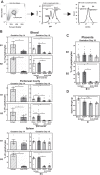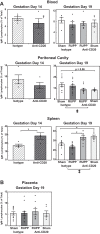Role of B1 and B2 lymphocytes in placental ischemia-induced hypertension
- PMID: 31397167
- PMCID: PMC6843018
- DOI: 10.1152/ajpheart.00132.2019
Role of B1 and B2 lymphocytes in placental ischemia-induced hypertension
Abstract
Preeclampsia is a prevalent pregnancy complication characterized by new-onset maternal hypertension and inflammation, with placental ischemia as the initiating event. Studies of others have provided evidence for the importance of lymphocytes in placental ischemia-induced hypertension; however, the contributions of B1 versus B2 lymphocytes are unknown. We hypothesized that peritoneal B1 lymphocytes are important for placental ischemia-induced hypertension. As an initial test of this hypothesis, the effect of anti-CD20 depletion on both B-cell populations was determined in a reduced utero-placental perfusion pressure (RUPP) model of preeclampsia. Anti-murine CD20 monoclonal antibody (5 mg/kg, Clone 5D2) or corresponding mu IgG2a isotype control was administered intraperitoneally to timed pregnant Sprague-Dawley rats on gestation day (GD)10 and 13. RUPP or sham control surgeries were performed on GD14, and mean arterial pressure (MAP) was measured on GD19 from a carotid catheter. As anticipated, RUPP surgery increased MAP and heart rate and decreased mean fetal and placental weight. However, anti-CD20 treatment did not affect these responses. On GD19, B-cell populations were enumerated in the blood, peritoneal cavity, spleen, and placenta with flow cytometry. B1 and B2 cells were not significantly increased following RUPP. Anti-CD20 depleted B1 and B2 cells in peritoneum and circulation but depleted only B2 lymphocytes in spleen and placenta, with no effect on circulating or peritoneal IgM. Overall, these data do not exclude a role for antibodies produced by B cells before depletion but indicate the presence of B lymphocytes in the last trimester of pregnancy is not critical for placental ischemia-induced hypertension.NEW & NOTEWORTHY The adaptive and innate immune systems are implicated in hypertension, including the pregnancy-specific hypertensive condition preeclampsia. However, the mechanism of immune system dysfunction leading to pregnancy-induced hypertension is unresolved. In contrast to previous reports, this study reveals that the presence of classic B2 lymphocytes and peritoneal and circulating B1 lymphocytes is not required for development of hypertension following third trimester placental ischemia in a rat model of pregnancy-induced hypertension.
Conflict of interest statement
No conflicts of interest, financial or otherwise, are declared by the authors.
Figures





Comment in
-
Reply to "Letter to the Editor: Importance of B cells in response to placental ischemia".Am J Physiol Heart Circ Physiol. 2020 Mar 1;318(3):H726-H728. doi: 10.1152/ajpheart.00104.2020. Am J Physiol Heart Circ Physiol. 2020. PMID: 32141767 No abstract available.
-
Letter to the Editor: Importance of B cells in response to placental ischemia.Am J Physiol Heart Circ Physiol. 2020 Mar 1;318(3):H723-H725. doi: 10.1152/ajpheart.00033.2020. Am J Physiol Heart Circ Physiol. 2020. PMID: 32141769 Free PMC article. No abstract available.
References
-
- Abais-Battad JM, Lund H, Fehrenbach DJ, Dasinger JH, Mattson DL. Rag1-null Dahl SS rats reveal that adaptive immune mechanisms exacerbate high protein-induced hypertension and renal injury. Am J Physiol Regul Integr Comp Physiol 315: R28–R35, 2018. doi:10.1152/ajpregu.00201.2017. - DOI - PMC - PubMed
-
- Alexander BT, Kassab SE, Miller MT, Abram SR, Reckelhoff JF, Bennett WA, Granger JP. Reduced uterine perfusion pressure during pregnancy in the rat is associated with increases in arterial pressure and changes in renal nitric oxide. Hypertension 37: 1191–1195, 2001. doi:10.1161/01.HYP.37.4.1191. - DOI - PubMed
Publication types
MeSH terms
Substances
Grants and funding
LinkOut - more resources
Full Text Sources
Other Literature Sources
Research Materials

